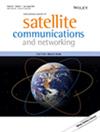卫星物联网干扰检测方法研究
IF 0.9
4区 计算机科学
Q3 ENGINEERING, AEROSPACE
International Journal of Satellite Communications and Networking
Pub Date : 2021-10-17
DOI:10.1002/sat.1431
引用次数: 0
摘要
尽管通过卫星进行的机器型通信快速增长,但此类网络易受蓄意干扰和恶意干扰攻击的问题令人担忧。具体而言,在本文中,我们讨论了一类干扰攻击,其中对手使用卫星物理和接入协议的基本知识来增加干扰影响。特别是,我们关注的是一种伪装干扰攻击(使用已知的前导码)来欺骗接收机,这种攻击会迅速导致性能不佳。与传统的持续干扰攻击相比,这些干扰策略更有效,对目标通信网络的危害更大。我们分析了检测此类干扰攻击的方法,并提供了卫星物联网(IoT)网络的干扰检测技术示例。结果表明,干扰检测技术对各种具有代表性的系统参数具有有效的性能。更具体地说,我们介绍了一种简单的(计数)干扰检测方法,以及实际系统参数的数值结果,该方法确认了系统设计的漏洞以及干扰机如何改进其策略。本文章由计算机程序翻译,如有差异,请以英文原文为准。
On jamming detection methods for satellite Internet of Things networks
Despite the fast growth of machine‐type communications via satellite, the vulnerability of such networks to intentional interference and malicious jamming attacks is a raising concern. Specifically, in this paper, we address a class of jamming attacks in which the adversary uses the underlying knowledge of the satellite physical and access protocol to increase the jamming impact. In particular, we focused on a type of camouflage jamming attack (using publicly known preamble) to deceive the receiver, which rapidly leads to poor performance. Compared to conventional constant jamming attacks, these jamming strategies are known to be more effective and potentially more harmful to the targeted communication network. We analyze methods to detect such jamming attacks and provide examples of jamming detection techniques for the satellite Internet of Things (IoT) networks. Results indicate the effective performance of the jamming detection techniques for a variety of representative system parameters. More specifically, we introduce a simple (counting) jamming detection method along with numerical results for realistic system parameters, which confirms system design vulnerability as well as how the jammer may improve her strategy.
求助全文
通过发布文献求助,成功后即可免费获取论文全文。
去求助
来源期刊
CiteScore
4.10
自引率
5.90%
发文量
31
审稿时长
>12 weeks
期刊介绍:
The journal covers all aspects of the theory, practice and operation of satellite systems and networks. Papers must address some aspect of satellite systems or their applications. Topics covered include:
-Satellite communication and broadcast systems-
Satellite navigation and positioning systems-
Satellite networks and networking-
Hybrid systems-
Equipment-earth stations/terminals, payloads, launchers and components-
Description of new systems, operations and trials-
Planning and operations-
Performance analysis-
Interoperability-
Propagation and interference-
Enabling technologies-coding/modulation/signal processing, etc.-
Mobile/Broadcast/Navigation/fixed services-
Service provision, marketing, economics and business aspects-
Standards and regulation-
Network protocols

 求助内容:
求助内容: 应助结果提醒方式:
应助结果提醒方式:


